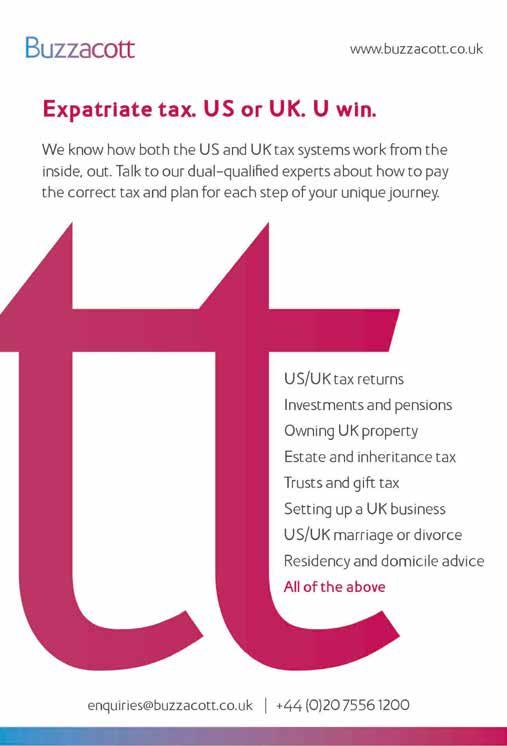
13 minute read
Tax – Personal
INTRODUCTION
Over recent years, the UK tax regime as it applies to expatriates has been rather turbulent, as successive Governments have overhauled key parts of the tax system as it affects expatriates. Indeed, over the past few years, this article has focused heavily on wide ranging changes to the domicile and remittance basis rules announced in 2015. This year, we go back to basics (if you can call any of these rules ‘basic’) and look at tax residence.
Advertisement
THE SCOPE OF UK TAXATION
The scope of UK income tax, capital gains tax, and inheritance tax is based on a person’s residence and domicile status, as well as on the source of income or capital gains, and for inheritance tax purposes the situs of assets.
Residence under UK tax law is determined by reference to a complex set of criteria known as the “Statutory Residence Test” (or “SRT”). Essentially, this works to treat a person as resident in the UK based on the extent of their connections to the UK and the amount of time that the person spends in the UK. Domicile is a concept of UK general law. A person’s domicile is generally the territory which that person considers to be their permanent home. Expatriates who have been in the UK for several years should also be aware of the concept of “deemed domicile”. Broadly speaking, this means that any person who has been resident in the UK at any point in fifteen out of the previous twenty tax years will be treated as domiciled in the UK for income tax, capital gains tax, and inheritance tax purposes.
For an expatriate in the UK, understanding their residence and domicile status is important to ensure that they are able to comply with the tax obligations imposed on them, and to allow them to understand the opportunities that may be available.
A person who is resident and domiciled in the UK is generally taxed in the UK on their worldwide income and capital gains, whereas someone who is not UK resident can usually only be taxed on UK source income or capital gains on the disposal of certain types of UK assets (e.g. real estate). Those who are resident but not domiciled or deemed domiciled in the UK can elect into the torturously complex but often advantageous remittance basis rules.
RESIDENCE AND THE STATUTORY RESIDENCE TEST
The SRT came into effect in 2013, and was an attempt to provide an unambiguous framework for determining a person’s residence status in the UK, as the Government at the time felt that the previous system contained too much uncertainty, resulting in opportunities for abuse. It is fair to say that, to a reasonable extent, the SRT does succeed in removing much of the uncertainty that surrounded the determination of residence for tax purposes. However, in doing so, it also added a great deal of complexity to the matter.
The SRT works by setting out a series of tests to be followed in order until a definitive conclusion can be reached.
STEP 1 – THE FIRST AUTOMATIC UK TEST (THE ”183 DAY RULE”)
The first, and perhaps most straightforward of these tests, specifies that a person will be considered resident in the UK for the tax year in question if that person has spent 183 days or more in the UK during that year.
For the purposes of this test (and for that matter, all of the other tests in the SRT which make reference to days spent in the UK), a person is considered to have spent a day in the UK if they are present here at the end of the day (i.e. at midnight on that day). As with all rules, this one does have exceptions which can impact a person’s day count.
One such exception is that being present at midnight does not count as a day in the UK if the person is merely in transit between two other locations. This means that you could arrive in the UK in the evening, check into a hotel near the airport, and leave the UK the following morning without being considered to have spent a day
here (provided that you do not engage in any activities that could be considered unrelated to your passage through the UK, such as meeting with friends, going into the office, etc.).
Additionally, days spent in the UK as a result of exceptional circumstances can be disregarded. This might typically be relevant to someone who is unexpectedly hospitalised whilst visiting the UK.
In certain circumstances, a person can also be deemed to be present for a day in the UK, even if they were not present at midnight. This will be relevant only in cases where the individual concerned was resident in the UK in at least 1 of the previous 3 years’, has at least 3 “ties” to the UK (more on these “ties” later), and has been in the UK during the year for more than 30 days without being present at midnight.
STEP 2 – THE AUTOMATIC OVERSEAS TESTS
If the 183 day test is not met, the SRT contains 3 tests which can automatically result in a person being considered not UK resident. 1. The first automatic overseas test provides that a person will not be considered resident in the
UK if they had been resident in at least 1 of the previous 3 years and have spent fewer than 16 days in the UK during the year in question. 2. The second automatic overseas test provides that a person will not be considered resident in the UK if they had not been resident in at least 1 of the previous 3 years and have spent fewer than 46 days in the UK during the year in question. 3. The third automatic overseas test applies where a person works “sufficient hours” overseas during the tax year without any significant breaks, spends less than 91 days in the UK during the tax year, and works for more than 3 hours during the day in the
UK on less than 31 days during the year.
Whether a person has worked for sufficient hours overseas is determined by reference to a somewhat convoluted formula, but broadly speaking, the threshold to meet is 35 hours per week of overseas work. The restrictive nature of these automatic overseas tests means that they are generally of little use to most expatriates who have come to the UK for anything other than very brief trips.
STEP 3 – THE SECOND AND THIRD AUTOMATIC UK TESTS
If you have made it through all of the above tests without reaching a definitive answer, the next step is to look at the remaining automatic UK tests. As the name suggests, meeting either of these tests will result in a person automatically being considered resident in the UK for tax purposes. 1. The second automatic UK test applies where, for an uninterrupted period of 91 days (30 of which must be in the tax year concerned), a person has; a. a home in the UK in which they are present on at least 30 days during the tax year; and either b. no home overseas; or c. an overseas home or homes in each of which they are present on fewer than 30 days during the tax year.
It is worth pointing out here that the 30 days of presence rules in this test do not follow the standard principle that you are considered present if you are here at midnight. A person is considered present in a home for a day if they spend any amount of time there at any point during the day. 2. The third automatic UK test is concerned with individuals who are considered to be working full-time in the UK. The test applies in cases where an individual works full-time in the UK for any period of 365 days with no significant break in their work, and a. all or part of the 365 period falls within the tax year; b. of the total number of days in the 365 day period on which the individual worked for more than 3 hours, more than 75% are days where they worked more than 3 hours in the
UK; and c. at least 1 day which is in both the 365 day period and the tax year is a day on which the individual worked more than 3 hours in the UK.
It should be noted that the definition of full-time work in the UK, much like that for the
third automatic overseas test, is based on a convoluted formula. However, the end result is similar – a person is generally considered to be working full-time in the UK if they work more than 35 hours per week here.
There are exceptions to this test for people whose job consists of performing duties on board a vehicle, aircraft, or ship while it is travelling.
STEP 4 – THE “SUFFICIENT TIES” TEST
If you have managed to work through all of the automatic tests outlined above, and are still unable to reach a definitive decision on your residence status in the UK, the final port of call is the sufficient ties test. This test works by allowing an individual to spend a certain amount of time in the UK without becoming resident here, but by fixing that amount of time on the extent of their ties to the UK (the more ties you have, the less time you can spend here).
For individuals who were not resident in the UK in any of the 3 preceding tax years, there are 4 ties that need to be considered: ‘family tie’, ‘accommodation tie’, ‘work tie’, and ‘90-day tie’. For those who had been resident in at least 1 of the preceding 3 tax years, a fifth ‘country tie’ is included.
A person is considered to have a family tie if any of the following are considered resident in the UK in their own right: their spouse or civil partner; their partner, if living together as husband and wife or as civil partners; or their child (if that child is under the age of 18 and if the person spends time with the child on at least 61 days during the year).
A person is considered to have an accommodation tie if they have a home available in the UK for a continuous period of at least 91 days during the year; and 1. They spend at least 1 night there during the year; or 2. If it is the home of a close relative (i.e. parent, grandparent, child, grandchild, or sibling), they spend at least 16 nights there during the year. A person is considered to have a work tie if they do more than 3 hours of work per day for a total of at least 40 days during the year.
A person has a 90-day tie if they have spent more than 90 days in the UK in either or both of the previous 2 tax years.
If relevant, a person will have a country tie if they have spent more days in the UK during the year than they have in any other country.
The following table indicated how many ties are needed for a person to be considered UK resident based on the number of days spent here.
SPLIT YEARS
The UK tax year ends on 5 April each year. The rules set out above determine whether a person is considered resident in the UK or not resident in the UK for the tax year, but it is possible to be resident for only part of a tax year, in which case the tax year is effectively split into two. This is commonly known as “split year” treatment.
The SRT provides guidance on no less than 8 sets of circumstances where split year treatment can apply. These are as follows: 1. Starting full-time work overseas. 2. Being the partner of someone starting full-time work overseas. 3. Ceasing to have a home in the UK. 4. Starting to have a home only in the UK. 5. Starting full-time work in the UK. 6. Ceasing full-time work overseas. 7. Being the partner of someone starting full-time work in the UK. 8. Starting to have a home in the UK.
Days Spent in the UK
16 – 45
46 – 90 91 – 120 UK Ties Needed Resident in 1 or More of the Not Resident in 1 or More of Previous 3 Years the Previous 3 Years 4 N/A
3 4
2 3
Each of these circumstances encompasses its own set of criteria and rules governing their applicability and the date on which the change in residence occurs. Furthermore, it is entirely possible that more than one circumstance might apply and where this is an issue, the SRT provides guidance on which takes priority.
DUAL RESIDENTS
As if this were not complex enough, the rules outlined here are applicable for UK tax purposes only. Other countries and taxing jurisdictions have their own rules governing tax residence. As a result, it is not beyond the realm of possibility to be considered resident in two places at the same time – something which can cause tax issues for those concerned.
Depending on which countries are involved, this problem can be mitigated through reliance on tax treaties – bilateral, or in some cases multilateral, agreements between countries to determine taxing rights where both jurisdictions can lay claim under their own domestic laws. Fortunately, the UK has one of the most extensive networks of tax treaties of any country.
Most tax treaties are based on the OECD Model treaty (except those to which the US is a party, as the US has its own Model treaty), and then modified by negotiation. As a result, most have almost identical articles dealing with cases of dual residence. Therefore, if a person is considered to be tax resident in the UK under the SRT, but also tax resident in another country with which the UK has a tax treaty, the terms of that treaty can override the SRT.
Both the OECD and the US Model treaties provide the following criteria for determining residence: 1. Where a person is resident in both countries under the laws of those countries, they shall be considered resident only on the country in which they have a permanent home. 2. If the person has a permanent home in both countries, they shall be considered resident only in the jurisdiction to which their personal and economic ties
are closer (known as their ‘centre of vital interests’). 3. If their centre of vital interests cannot be determined, or if they have a permanent home in neither country, they are resident only in the country in which they have a habitual abode. 4. If the person has a habitual abode in both countries or in neither, they are considered resident only in the country of which they are a national. 5. If the person is a national of both countries or of neither, the authorities of both countries must settle the case by mutual agreement. Whilst reliance on the tax treaties can be extremely helpful, it is a specialised area and should be properly disclosed on tax filings. It is also worth pointing out that, if you do happen to be a US citizen, you can use treaty provisions such as the one noted above to prevent yourself inadvertently becoming resident in another country (e.g. the UK), but not to claim non resident status in the US.
All of this demonstrates that determining your residence status for tax purposes is infinitely more complicated than you might reasonably expect, and care should be taken in this regard as HM Revenue & Customs do periodically like to make enquiries into tax returns with a particular focus on residence issues.

Information was correct at time of printing It is advisable to always contact a financial adviser or a tax specialist when considering your financial affairs.








